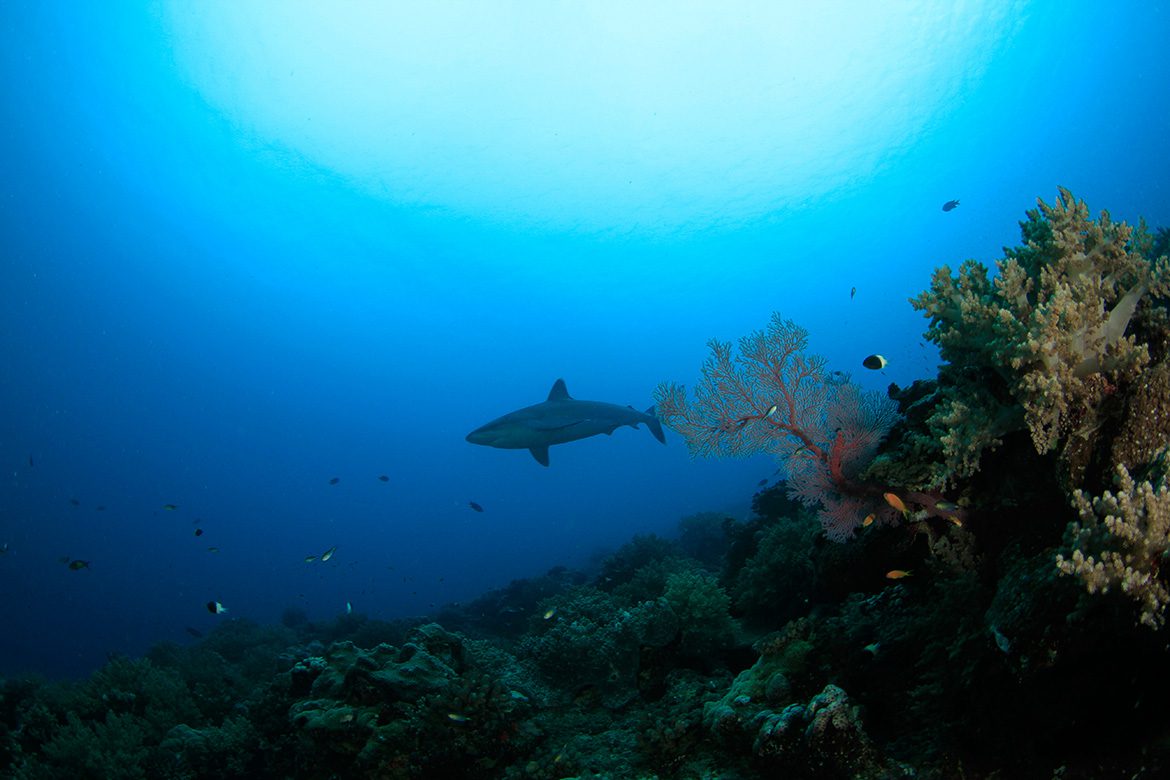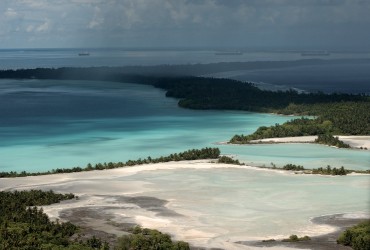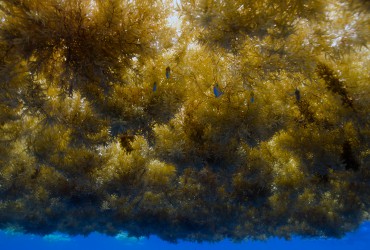Freshwater predator
Since 2011, the small volcanic Réunion Island is shaken by a tragic series of deadly shark attacks. Nobody really knows why, and countless rumors act as road blocks towards general agreement and solutions.
To answer the many questions asked by the grieving population and paralyzed public authorities, and to fill the embarrassing gap of knowledge on shark behavior, an ambitious scientific program named CHARC for “Knowledge of the Ecology and Habitat of two Species of Coastal Sharks” was launched at the end of 2011. Marc Soria, researcher for the French Institute of Research and Development in Saint-Denis, took the lead. “To be fully effective, the research should have started years before the series of accidents, Soria tells me. We proposed a project in 2006 and 2007, but the funds were not allocated. At that time, all we talked about was the chikungunya. All of a sudden, they opened the floodgates: we received 800’000 euros for three years. And no room for error.” CHARC’s first challenge was to capture, tag and release 80 animals. 40 tiger sharks and 40 bull sharks. A world first.
The tiger shark quota was relatively quickly met. They tend to take a bite out of every available food lying around. Yet, local fishermen just couldn’t get their hands and hooks on the population of bull sharks. Several months went by without a single hit. Christophe “Criquet” Perry is considered one of the best bull shark fisherman in Réunion Island. When I asked him why this predator is so hard to catch, he answered: “It’s a special fish that has evolved to have serious advantaged on his competitors. It’s a very intelligent and cautious animal. Personally, I think that sharks that swim in the waters of Réunion Island have all been in contact with fishermen at least once in their lives. It’s not like in Australia or elsewhere, where the areas are so big that these animals can live their entire life without seeing a single human. Here, they have an additional experience.”
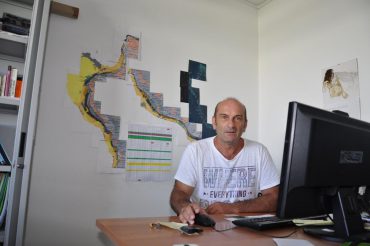 After trying different techniques over many months, 79 sharks were finally caught, tagged with an acoustic beacon and released. From then on, and for approximately 2 years, every tagged shark had its presence recorded as it swam in the range of one of the 44 emitting buoys disseminated along Réunion’s coast. “CHARC’s main interest was to set a point of reference for the future, says Marc Soria. Also, we were able to show that these species of shark have a varying presence according to different seasons: our tagged animals are larger in numbers between March and June in Réunion Island, which corresponds to the early winter in the Southern Hemisphere.” The study also proved that some sharks stay several days in the same small area, while others swim all around the island in as few as four days. CHARC also confirmed what is considered as common knowledge by generations of surfers: large marine predators are much more present near the coast when it has been steadily raining, and when a large swell stirs up the suspended particles. Those are the two main ingredient for murky waters and poor underwater visibility, a synonym for higher risk and caution.
After trying different techniques over many months, 79 sharks were finally caught, tagged with an acoustic beacon and released. From then on, and for approximately 2 years, every tagged shark had its presence recorded as it swam in the range of one of the 44 emitting buoys disseminated along Réunion’s coast. “CHARC’s main interest was to set a point of reference for the future, says Marc Soria. Also, we were able to show that these species of shark have a varying presence according to different seasons: our tagged animals are larger in numbers between March and June in Réunion Island, which corresponds to the early winter in the Southern Hemisphere.” The study also proved that some sharks stay several days in the same small area, while others swim all around the island in as few as four days. CHARC also confirmed what is considered as common knowledge by generations of surfers: large marine predators are much more present near the coast when it has been steadily raining, and when a large swell stirs up the suspended particles. Those are the two main ingredient for murky waters and poor underwater visibility, a synonym for higher risk and caution.
During cyclone season, tremendous amounts of rainwater fall on Réunion’s mountains, causing erosion and runoffs. Eventually, all this organic matter ends up in the ocean, more often than not accompanied by rubbish and pollution. The salt water is mixed up with tons of particles and fresh water, which decreases the ocean’s salinity. Many corals and marine animals suffer from these conditions, but the bull shark couldn’t ask for more. One of his “serious advantages on his competitors” is his osmoregulation. It’s the ability to modify the salt concentrations in the body depending on the immediate environment. When a bull shark swims in the open ocean, it can expulse the salt through its kidneys because the levels keep replenishing. Once it enters a less salty environment such as an estuary, the kidneys conserve the levels to what is necessary to survive. Very few fish are able to do this. On top of this, the bull shark doesn’t really need his eyes to hunt, which are particularly small compared to other species of similar sizes. It rather relies on its scent, lateral line an ampullae of Lorenzini, making it a formidable predator in turbid waters.
One of the most interesting findings of the CHARC study was how the tagged bull sharks behave on a daily basis: in the morning, the predators tend to be relatively far from the coast, and at the bottom of the sea. Then from around two p.m. onwards, they approach the shore and swim higher in the water column. The closer to sunset, the more active they become.
Marc Soria also believes in the existence of a “mating arena”: “In ornithology, we call it a “lek”. It’s not a colony, rather a particular zone where males and females meet when the species is usually scattered over large areas. There could be such an arena around Saint-Gilles and another around Saint-Leu, but not necessarily every year. We also believe that a nursing zone exists close to the Saint-Louis river mouth.”
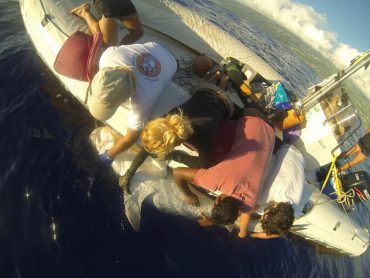 While the CHARC scientific program was under way, sharks unfortunately kept on attacking surfers and swimmers. Even as the prefecture ordered everybody out of the water and passed a temporary law to forbid marine activities on all open beaches. The high risk and the law drastically diminished the number of surfers, but still, accidents continued. The IRD researcher thinks that “there aren’t more attacks because there are many more sharks and surfers than before. Rather than quantitatively, it’s qualitatively that we need to think. Is the shark starving because the oceans have been over-fished? Is it a stressed male during a mating period, and competition is fierce for female attention? Is it on the hunt and sees a surfer acting as a wounded prey, splashing in the water and obviously unaware of its presence underneath? In its mind, there are maybe a set of lights that turn to green, and at a certain point it decides it’s worth trying an attack.”
While the CHARC scientific program was under way, sharks unfortunately kept on attacking surfers and swimmers. Even as the prefecture ordered everybody out of the water and passed a temporary law to forbid marine activities on all open beaches. The high risk and the law drastically diminished the number of surfers, but still, accidents continued. The IRD researcher thinks that “there aren’t more attacks because there are many more sharks and surfers than before. Rather than quantitatively, it’s qualitatively that we need to think. Is the shark starving because the oceans have been over-fished? Is it a stressed male during a mating period, and competition is fierce for female attention? Is it on the hunt and sees a surfer acting as a wounded prey, splashing in the water and obviously unaware of its presence underneath? In its mind, there are maybe a set of lights that turn to green, and at a certain point it decides it’s worth trying an attack.”
In the growing world of shark specialists, there is an unanimous statement: humans are not on the shark’s menu. François Sarano is an oceanographer and the founder of the association “Longitude 181 Nature”. He has been diving with most of the largest sharks for years, and shares with us his compellingly logical arguments: “It’s quite simple really. At this very moment, hundreds of thousands of people are surfing, swimming or diving on the sharks’ territory. If the predator was interested in us as a prey, we wouldn’t account a hundred accidents every year, but thousands. It would be so common that you wouldn’t be writing this article. Above all, there wouldn’t be so many swimmers as today.”
Another fact highlighted by the French oceanographer is that shark attack victims are hardly ever eaten by the predator. “The first bites are often a mistake, says François Sarano. Since we are physically incapable of escaping, unlike a sea lion for example that has incredibly more velocity in the water than humans, sharks could easily come back to get us. But they don’t. Most of the time, when a surfer is bitten, he is able to reach the shore alone or with his friends’ help. When the victim dies, it’s from a hemorrhage, on the beach or at the hospital.”
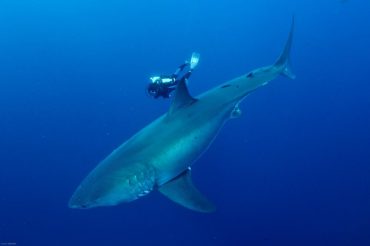 After countless hours diving along the greatest predators of the oceans, François Sarano noticed that sharks don’t share the same behavior. “It’s the diversity of the living, he says. Some would say that shark have personalities, even among the same species. If it’s a male or a female, a young or an adult, some will be more inquisitive, more cautious or more aggressive.” Despite this observation, the founder of the Longitude 181 association is opposed to any shark culling program aimed at securing the beaches of Réunion Island. “First of all, he explains, we never catch the animal responsible for the attack. We tend to think that sharks are manipulative and calculating predators, like the notorious Beast of Gévaudan. If the accidents were all provoked by a single perverse animal, I would have myself asked for its capture and elimination. The fact is that today, every shark that dares to approach Réunion’s coast is automatically found guilty and sentenced to death.”
After countless hours diving along the greatest predators of the oceans, François Sarano noticed that sharks don’t share the same behavior. “It’s the diversity of the living, he says. Some would say that shark have personalities, even among the same species. If it’s a male or a female, a young or an adult, some will be more inquisitive, more cautious or more aggressive.” Despite this observation, the founder of the Longitude 181 association is opposed to any shark culling program aimed at securing the beaches of Réunion Island. “First of all, he explains, we never catch the animal responsible for the attack. We tend to think that sharks are manipulative and calculating predators, like the notorious Beast of Gévaudan. If the accidents were all provoked by a single perverse animal, I would have myself asked for its capture and elimination. The fact is that today, every shark that dares to approach Réunion’s coast is automatically found guilty and sentenced to death.”
Others beg to differ. Indeed, the bull shark is philopatric, which means that the pregnant females come back to where they were born, much like marine turtles or salmons. By targeting these specimens, the hope is to avoid a settlement and exponential growth of the bull shark’s population. It is worth noting that several pregnant females were recently caught, one of which had 13 babies in its belly.
According to the numerous observations, pregnant females are not the only bull sharks to visit the coast in Réunion Island. Juveniles were filmed in rivers for the first time, and several swimmers were charged by sub adults that renounced at the last second and swam away. Of course, there are also adult bull sharks, with sizes that flirt with world records. All the signs point towards a healthy population that have an opportunity to grow old around Réunion Island and in the Indian Ocean
Several reasons may explain why certain species of sharks are disappearing, and why others seem to thrive. First of all, in the 1990s, a series of fatal intoxications following shark meat consumption took place in Madagascar. Public authorities feared a wide spread sanitation risk of the ciguatera, a contamination of fish meat coming from a micro-algae present in the Indian Ocean. Like all other contaminations, it’s always the large fish at the top of the food chain that have the highest concentration. Consequently, it was decided to ban the buying and selling of many different species of fish throughout the region, including meat from bull and tiger sharks. While these two species had been traditionally fished and eaten in Réunion Island for decades, they almost instantly lost all commercial value and thus benefited from the best kind of protection, an economical one.
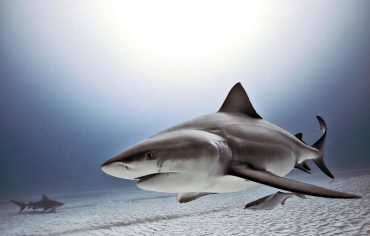 Secondly, in 2005 and almost ten years prior to the European Union, “finning” (often barbaric practice that consists of cutting off the fins of a shark before throwing the dying animal back into the sea) was banned in Réunion Island. David Guyomard is an engineer at the Fishing Committee and he tells me the story behind the good news: “It wasn’t at all for environmental or moral reasons. Before 2005, fishermen from Réunion Island, like every fisherman in the Indian Ocean, used to bring back shark fins to port after each campaign. Most of the time, they targeted pelagic animals, so the tiger shark must have been one of the victims of this practice. Anyway, Asian buyers would go around the docks and buy all the dried fins, and the fishermen would use this little bonus to buy cigarettes for example. One day, a ship-owner saw the potential and started buying the fins off his sailors, to sell them directly to the Asian buyers. Apparently, only the fish meat was declared and the fins were negotiated on the black market. When the director of maritime affaires discovered the scheme during one of his controls, he straight away decided to ban all finning activities throughout the island.” Progressively, large sharks weren’t killed anymore for their fins neither for their meat. The two species of bull and tiger shark lost all their commercial value in a little less than 15 years, and could reproduce in peace.
Secondly, in 2005 and almost ten years prior to the European Union, “finning” (often barbaric practice that consists of cutting off the fins of a shark before throwing the dying animal back into the sea) was banned in Réunion Island. David Guyomard is an engineer at the Fishing Committee and he tells me the story behind the good news: “It wasn’t at all for environmental or moral reasons. Before 2005, fishermen from Réunion Island, like every fisherman in the Indian Ocean, used to bring back shark fins to port after each campaign. Most of the time, they targeted pelagic animals, so the tiger shark must have been one of the victims of this practice. Anyway, Asian buyers would go around the docks and buy all the dried fins, and the fishermen would use this little bonus to buy cigarettes for example. One day, a ship-owner saw the potential and started buying the fins off his sailors, to sell them directly to the Asian buyers. Apparently, only the fish meat was declared and the fins were negotiated on the black market. When the director of maritime affaires discovered the scheme during one of his controls, he straight away decided to ban all finning activities throughout the island.” Progressively, large sharks weren’t killed anymore for their fins neither for their meat. The two species of bull and tiger shark lost all their commercial value in a little less than 15 years, and could reproduce in peace.
Simultaneously, the west coast of Réunion was becoming a victim of its own success. The galloping urbanization means that soil was covered in concrete in many places. It’s understandable that people living on an island prefer to settle where the weather is always nice. Only, the water treatment plants were never able to keep up. Year after year, more rubbish and polluted water washed up in the ocean. When there is too much organic matter, the water gets murky and corals suffocate. All of the fragile marine life suffered. “Twenty years ago, remembers Marc Soria from the IRD, there were already very few reef sharks. It’s the indication of an ecosystem in bad health.” The rare specimens that resisted to the change in their environment were decimated by recreational fishermen who are not subjected to the same rules as professionals.
In the open ocean, the population of tiger sharks was left alone and increased, as observed by professional fishermen who work over the Sec, an underwater plateau that surrounds Réunion island on which edge mix up coastal and pelagic species. It’s the perfect place for a good fishing campaign, but now the catches are often munched by tiger sharks looking for easy food. Yet, very few bull sharks annoy the fishermen working on the Sec. Based on the CHARC scientific study, Marc Soria explains why: “The two species of bull and tiger sharks don’t really share the same territory. The tiger is a pelagic animal that spends most of its time in the open ocean. We can often see them around the fish-aggregating devices that are five miles out. Bull sharks will remain less than one kilometer away from the coast. It may happen that they occupy the same space, but hardly ever at the same time of day. That way, they avoid an interspecific competition.”
The edge of the Sec slowly became the primary territory of a growing number of tiger sharks, putting a pressure on the bull shark population to stay closer to shore. Once on the west coast, these predators found a struggling ecosystem, with large amounts of fresh water in certain places, a higher turbidity with every rainfall and swell, and most of all, an ecological niche abandoned by reef sharks. “Reef sharks are territorial animals, explains Marc Soria. When they live in an area, they don’t leave enough prey for animals that have the same fish-based alimentation, such as the bull shark and kingfish.”
When the marine reserve was inaugurated in 2007 on most of the west coast of Réunion Island, the coastal sharks saw the disappearance of their fiercest competitor: humans. Historically, these men equipped with masks, fins and spear guns would prove to be a daily dissuasive barrier. The marine reserve also put an end to countless fishing boats and jet skis roaming the area. The only species of humans that continued to go in the open ocean were the surfers, now very alone in the deep blue.
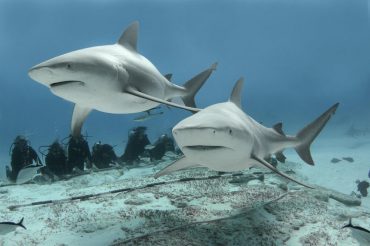 Around the globe, many places are known for the seasonal presence of bull sharks, such as Playa del Carmen in Mexico. Over there, the big marine predators are peaceful and curious. Divers looking for the thrill can be taken to the seafloor to observe the animals in total safety. But in Réunion Island, the same species is elusive and aggressive. If we can obviously not put all the sharks in the same net, the peculiarity of what is happening off the coast of Réunion Island is puzzling.
Around the globe, many places are known for the seasonal presence of bull sharks, such as Playa del Carmen in Mexico. Over there, the big marine predators are peaceful and curious. Divers looking for the thrill can be taken to the seafloor to observe the animals in total safety. But in Réunion Island, the same species is elusive and aggressive. If we can obviously not put all the sharks in the same net, the peculiarity of what is happening off the coast of Réunion Island is puzzling.
Can the situation come back to “normal” in Réunion Island? Must we give nature enough time do what it does best, which is to find balance? Or must we deal with these large marine predators as quickly as possible, before it’s too late? People from Réunion Island, the French public authorities, the beach goers and the nature conservancy associations can simply not make up their mind and work together.
It definitely wasn’t the easiest of tasks, but original ideas are spawning and being tested. In fact, the French island and its shark crisis have become a thrilling research laboratory for those interested in studying the relationship mankind has with the marine predators, and with itself.
